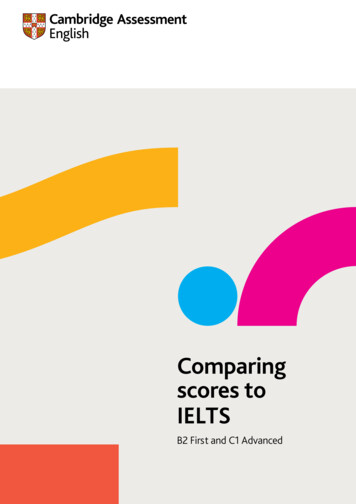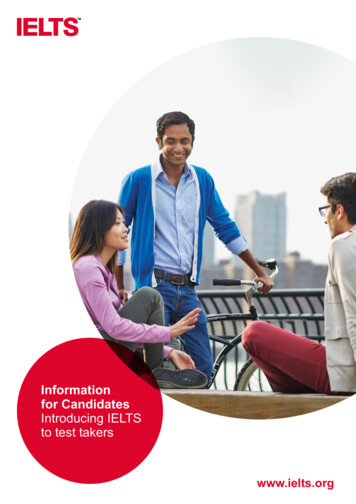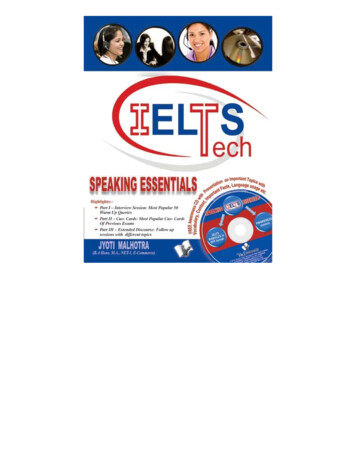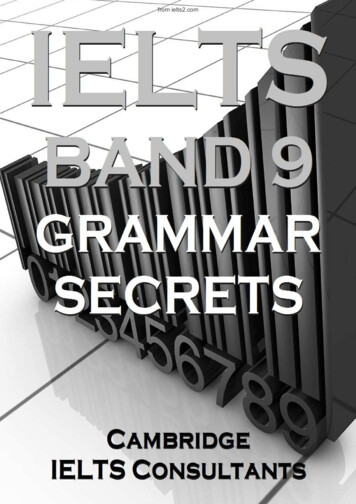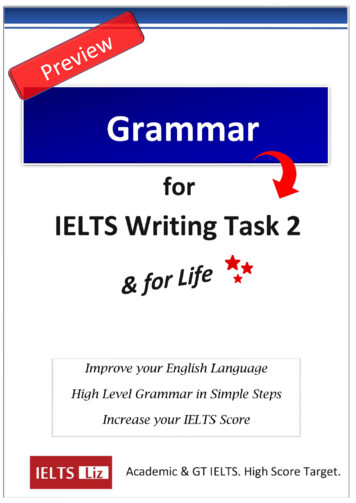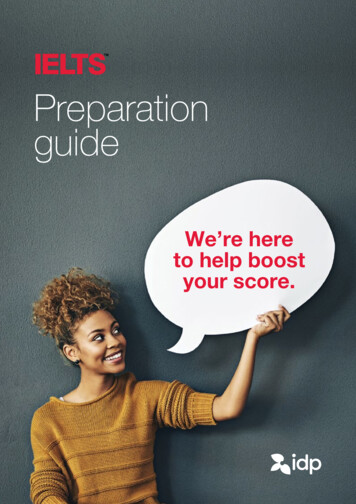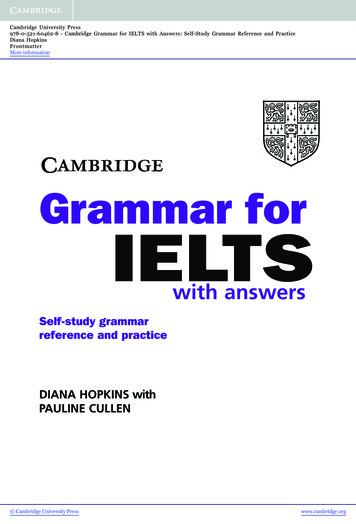
Transcription
Cambridge University Press978-0-521-60462-8 - Cambridge Grammar for IELTS with Answers: Self-Study Grammar Reference and PracticeDiana HopkinsFrontmatterMore informationGrammar forIELTSwith answersSelf-study grammarreference and practiceDIANA HOPKINS withPAULINE CULLEN Cambridge University Presswww.cambridge.org
Cambridge University Press978-0-521-60462-8 - Cambridge Grammar for IELTS with Answers: Self-Study Grammar Reference and PracticeDiana HopkinsFrontmatterMore informationCAMBRIDGE UNIVERSITY PRESSCambridge, New York, Melbourne, Madrid, Cape Town, Singapore, São PauloCambridge University PressThe Edinburgh Building, Cambridge CB2 2RU, UKwww.cambridge.orgInformation on this title: www.cambridge.org/9780521604628 Cambridge University Press 2007This publication is in copyright. Subject to statutory exceptionand to the provisions of relevant collective licensing agreements,no reproduction of any part may take place without the writtenpermission of Cambridge University Press.First published 2007Printed in the United Kingdom at the University Press, CambridgeText typeface GammEF 11.5/13pt System QuarkXpress(r) [KAMAE]A catalogue record for this publication is available from the British LibraryLibrary of Congress Cataloguing in Publication dataISBN–13 978–0–521–60462–8ISBN–10 0–521–60462–1Produced by Kamae Design, Oxford. Cambridge University Presswww.cambridge.org
Cambridge University Press978-0-521-60462-8 - Cambridge Grammar for IELTS with Answers: Self-Study Grammar Reference and PracticeDiana HopkinsFrontmatterMore informationAcknowledgementsMy thanks go firstly to my editor, Jessica Roberts, who has worked tirelessly and patiently with me and kept me goingthrough her endless words of encouragement. Thanks also to my commissioning editor, Alison Sharpe, whoseencouragement and gentle persuasion have led the project to completion, and to Anna Teevan, who saw me through theinitial stages. Many thanks also to all at Cambridge University Press who have contributed along the way, and to theteachers and readers involved in commenting on the material. And of course I would like to thank Pauline Cullen,without whom this book may never have quite reached the final stages and whose contribution has been muchappreciated.Finally, a thank you to my children Laura and Alexander, my partner, Ned Garnett and my mother, for their support,encouragement and help at every stage.Diana HopkinsThe authors and publishers would like to thank the following teachers and readers who commented on the materialin its draft form:Guy Brook-Hart, Valencia, Spain; Mike Gutteridge, Cambridge, England; Vanessa Jakeman, Hove, England; BarbaraThomas, Cambridge, England.The authors and publishers are grateful to the following for permission to reproduce copyright material. It has notalways been possible to identify the sources of all the material used and in such cases the publishers would welcomeinformation from the copyright owners.p.14: New Scientist for the adapted article ‘Good vibrations help jumping spiders to hunt’ by Peter Aldous, 24 February1996 from www.newscientist.com; p.60: The Economist for the text adapted from the article ‘Dressed to dazzle’ by BarneySouthin, and for p.71: listening text adapted from ‘Back on the treadmill’ by Konstantin Kakaes, Economist IntelligentLife, Summer 2004, The Economist Newspaper Limited; p.64: ESA for adapted listening text ‘World’s LargestSwitchboard for Climate Monitoring’ from www.innovations-report.com; p.87: Wcities for the adapted text fromwww.wcities.com, Wcities 2006; p.88: adapted from an article ‘Great Guide – Buying a Backpack’ in the Rambler,former members’ magazine of the Ramblers’ Association, www.ramblers.org.uk; p.103: Professor Rajendra Persaud for thetext ‘Practical Intelligence Lends a Hand’ taken from www.caribvoice.org; p.113: Roger Hedge for the adapted text‘Discovery and Prehistory of Soap’ from www.butser.org.uk; p.140: Professor John Maule for the adapted article ‘HowConsumers Decide’ from www.faradaypackaging.com; p.160: Bristol Magazines Ltd for the adapted article ‘We are family’by Philip Dalton from BBC Wildlife Magazine, November 2004; p.180: Auspac Media for the adapted text from ‘RoboticApproach to Crop Breeding’ by Jennifer Manyweathers, Australasian Science Magazine, March 2006; p.206: ScientificAmerican Inc., for article adapted from ‘Experience Versus Speed’ by Marion Sonnenmoser, Scientific American Mind,Volume 16, Number 2, 2005, Copyright 2005 by Scientific American Inc, All rights reserved.Photographs: Alamy Images/ Stockdisc for p8 (crt), / Mark Sykes for p8 (crb), / D Hurst for p11 (r), / Lebrecht Music& Arts PL for p27, / Rena Pearl for p80 (l), / B.Mete Uz for p80 (m), / Sciencephotos for p140, / Motoring PictureLibrary for p144 (l), / Epictura for p144 (ml), / Image Broker for p169; Corbis Images/ Bettmann for p11 (l), / DavidBall for p38 (c), / Gideon Mendel for p41, / Charles Jean Marc/Sygma for p42, / Viviane Moos for p80 (r), / RichardKlune for p98 (l), / Stephen Frink for p 98 (r), / Royalty Free for p144 (cr), / Chris Collins for p144 (br), / KeithDannemiller for p150, / Guenter Rossenbach/Zefa for p188, / Photocuisine for p198; Dell for p8 (cl);Empics/ AP/Vincent Thian for p69; FLPA/ Mark Moffett/Minden Pictures for p14; Getty Images for pp8 (r), 38 (r), 90;Photolibrary.com/ Thom DeSanto for p8 (c), / Royalty Free for p38 (l); Punchstock/ Image Source for p144 (tr),/ Digital Vision for p160, / Image Source for p154, / Bananastock for p210 (l); Rex Features for pp8 (l), 32, 64, 210 (r);Royal Ontario Museum ROM for p112 (reproduced with permission); Topfoto/ UPP for p158.Key: l left, c centre, r right, t top, b bottomPicture Research by Hilary Luckcockiii Cambridge University Presswww.cambridge.org
Cambridge University Press978-0-521-60462-8 - Cambridge Grammar for IELTS with Answers: Self-Study Grammar Reference and PracticeDiana HopkinsFrontmatterMore informationContentsIntroductionEntry testviiix1 Present tenses16present simple; present continuous; state verbsTest practice: Listening Section 12 Past tenses 1814past simple; past continuous; used to; wouldTest practice: Academic Reading3 Present perfect1825present perfect simple; present perfect continuousTest practice: General Training Writing Task 14 Past tenses 22734past perfect simple; past perfect continuousTest practice: Academic Reading5 Future 1plans, intentions and predictions: present continuous; going to; willTest practice: General Training Reading38446 Future 2present simple; be about to; future continuous; future perfectTest practice: Academic Writing Task 248547 Countable and uncountable nounscountable and uncountable nouns; quantity expressions (many, much, a lot of, some, any, a few, few, no)Test practice: Academic Reading55608 Referring to nounsarticles; other determiners (demonstratives, possessives, inclusives: each, every, both, all etc.)Test practice: Listening Section 464719 Pronouns and referencingpersonal, possessive and reflexive pronouns; avoiding repetitionTest practice: Academic Writing Task 2737910 Adjectives and adverbsdescribing things; adding information about manner, place, time, frequency and intensityTest practice: General Training Reading8087iv Cambridge University Presswww.cambridge.org
Cambridge University Press978-0-521-60462-8 - Cambridge Grammar for IELTS with Answers: Self-Study Grammar Reference and PracticeDiana HopkinsFrontmatterMore information11 Comparing things:comparative and superlative adjectives and adverbs; other ways of comparingTest practice: Academic Writing Task 1909712 The noun phrasenoun prepositional phrase; noun participle clause; noun to-infinitive clauseTest practice: Academic Reading9810313 Modals 1107113ability; possibility; alternatives to modalsTest practice: Listening Section 414 Modals 2obligation and necessity; suggestions and advice; adverbsTest practice: General Training Reading11412015 Reported speechtense changes; time references; reporting questions; reporting verbsTest practice: Listening Section 312313116 Verb verb patternsverb to-infinitive; verb -ing; verb preposition -ing; verb infinitive without toTest practice: Academic Reading13314017 Likelihood based on conditions 1zero, first and second conditionals; other ways to introduce a conditionTest practice: Academic Reading14415018 Likelihood based on conditions 2third conditional; mixed conditionals; wishes and regrets; should(n’t) haveTest practice: Academic Reading15416019 Prepositionsprepositions after verbs, adjectives and nouns; prepositional phrasesTest practice: Listening Section 216417120 Relative clausesrelative pronouns; defining and non-defining relative clauses; prepositionsTest practice: Academic Reading173180v Cambridge University Presswww.cambridge.org
Cambridge University Press978-0-521-60462-8 - Cambridge Grammar for IELTS with Answers: Self-Study Grammar Reference and PracticeDiana HopkinsFrontmatterMore information21 Ways of organising textssubject choice; introductory it; ellipsis; organising information; it- and what-clausesTest practice: Academic Writing Task 218419022 The passivethe passive; reporting with passive verbs; have something done; need -ingTest practice: Academic Writing Task 119119723 Linking ideasconjunctions, adverbials and prepositions; linking expressionsTest practice: Academic Reading19820624 Showing your position in a text210215pronouns; adverbs; verbs; adjectivesTest practice: Academic Writing Task 225 Nominalisation in written Englishforming nouns from other parts of speech (verbs, adjectives and linking words)Test practice: Academic Writing Task 1216222Key223Recording scripts240Appendix 1: Irregular verbs256Appendix 2: Phrasal verbs257CD tracklist258vi Cambridge University Presswww.cambridge.org
Cambridge University Press978-0-521-60462-8 - Cambridge Grammar for IELTS with Answers: Self-Study Grammar Reference and PracticeDiana HopkinsFrontmatterMore informationIntroductionTo the studentD: Test practice Each unit has a test task.These help you practise the different parts ofthe test. The test task is followed by agrammar focus task, which gives you extrapractice in the grammar from the unit.Who is this book for?This book is for anyone preparing for IELTS.Although the IELTS test does not include aspecific grammar module, it is important tobe able to recognize and use grammarappropriately. This book covers the grammaryou will need to be successful in the test. Youcan use it to support an IELTS coursebook,with a general English language course forextra grammar practice, or with practice testsas part of a revision programme. You can useit in class or for self-study.The KeyThe Key contains: answers for all the exercises. Check youranswers at the end of each exercise. TheKey tells you which part of the Grammarsection you need to look at again if youhave any problems. sample answers for exercises where youuse your own ideas to help you check yourwork. test tips for each exercise type in the Testpractice section. sample answers for all the writing tasks inthe Test practice section. Read these afteryou have written your own answer. Studythe language used and the way the ideasare organised.How do I use this book?There are two ways to use this book. You caneither start at Unit 1 and work through to theend of the book, or you can do the Entry teston page ix to find out which units you needmost practice in and begin with those.What is in this book?This book contains 25 units. Each unit is infour parts:A: Context listening This introduces thegrammar of the unit in a context that isrelevant to the IELTS test. This will help youto understand the grammar more easily whenyou study section B. It also gives you usefullistening practice. Listen to the recording andanswer the questions. Then check youranswers in the Key before you read theGrammar section.Recording scriptsThere are recording scripts for the Contextlistenings in each unit and for the Testpractice listening tasks. Do not look at thescript until after you have answered thequestions. It is a good idea to listen to therecording again while you read the script.The Entry testYou can do this test before using the book tohelp you choose what to study. Answer thequestions and then check your answers in theKey. The Key tells you which units are mostimportant for you.B: Grammar Read through this sectionbefore you do the grammar exercises. Foreach grammar point there are explanationswith examples. You can refer back to thissection when you are doing the exercises.C: Grammar exercises Write your answers toeach exercise and then check them in the Key.vii Cambridge University Presswww.cambridge.org
Cambridge University Press978-0-521-60462-8 - Cambridge Grammar for IELTS with Answers: Self-Study Grammar Reference and PracticeDiana HopkinsFrontmatterMore informationTo the teacherC: Grammar exercises This section can bedone in class or set as homework. Studentscan be encouraged to check their own workand discuss any difficulties they encounter.This book offers concise yet comprehensivecoverage of the grammar necessary in orderto be successful in the IELTS test. It can beused for self-study or with a class. It will beparticularly useful for a class where all thestudents are preparing for IELTS. It will alsobe useful for revision, and for candidates inclasses where some students are not enteredfor the test, as sections A, B and C aredesigned to be useful for all students.D: Test practice This section can be used tofamiliarize students with the test task typeswhile offering further practice in thegrammar for each unit. Each task is followedby a Grammar focus task, designed to raisestudents’ awareness of a particular languagepoint covered in that unit. The book containsat least one task from each part of theListening, Academic Reading, GeneralTraining Reading, Academic Writing andGeneral Training Writing modules.The Entry testThe Entry test can be used diagnostically as ameans of prioritising the language areas to becovered, either for a class, or for individualstudents.In classes where there are students who arenot entered for the test, you may prefer to setSection D tasks as extra work for IELTScandidates only. However, they offer allstudents valuable opportunities to practisethe grammar of the unit and provide aneffective teaching resource for EAP classes.A: Context listening This section is suitablefor classroom use. Many of the tasks can bedone in pairs or small groups if appropriate.B: Grammar This section is designed forprivate study, but you may wish to discussthose parts which are particularly relevant toyour students’ needs.viii Cambridge University Presswww.cambridge.org
Cambridge University Press978-0-521-60462-8 - Cambridge Grammar for IELTS with Answers: Self-Study Grammar Reference and PracticeDiana HopkinsFrontmatterMore informationEntry testYou can do this test before using the book to help you choose what to study. Choose the correctanswer, A, B or C, for each question. When you have finished, check your answers on page 223.The key tells you which units are most important for you.1 Most university studentscampus in their first year.A livesB liveC are living7onthe experiment three timesnow with different results each time!A We’ve doneB We didC We’ve been doing2 From this graph we can see that theeconomyat the moment.A improvesB improveC is improving8 When I arrived the lectureI didn’t find it easy to follow.A startedB had startedC had been starting3 Theypersonal computerswhen my father was a student.A hadn’tB didn’t haveC weren’t having9 Shewell at school but thatchanged when she became friends witha different group of girls.A didB had doneC had been doing4 Iwant to be a practisingdoctor but now I’m more interested inresearch.A was used toB used toC would10sothe doctor at 2.00 thisafternoon so I can’t go to the lecture.A I’m seeingB I seeC I will see5 The teacherus how to do theexperiment when the fire bell rang.A showedB shownC was showing11 My sistereconomics andpolitics when she goes to university.A is going to studyB studiesC will study6 I finished my essay yesterday butit in to the tutor yet.A I’ve givenB I haven’t givenC I didn’t give12 While we’re working on the project ourbosson a beach in Greece!A will sitB will have satC will be sittingix Cambridge University Presswww.cambridge.org
Cambridge University Press978-0-521-60462-8 - Cambridge Grammar for IELTS with Answers: Self-Study Grammar Reference and PracticeDiana HopkinsFrontmatterMore information2513 If the trend continues, the averageincomeby 107% by 2020.A will increaseB will have increasedC will be increasing20 You should visit Bath. It’scity.A a historical and interestingB a historical interestingC an interesting historical14 You can base your geographyassignment oncountry – itdoesn’t matter which.A aB someC any21 The government has released somedata showing how schools arenot providing an adequate education toour children.A shockingB shockC shocked15 There aren’tplaces left onthe course so you’d better apply soon.A muchB manyC lots of22 You really should go to Namibia. Thescenery isstunning and thepeople are very friendly.A veryB fairlyC absolutely16 I don’t know whether to accept the joboffer. It’s.A a difficult decisionB the difficult decisionC difficult decision23 This factory produces some ofcameras in the world.A bestB the bestC the most best17 For those of you new to the company,this leaflet is full of.A a valuable informationB the valuable informationC valuable information2418 The manager interviewedcandidates in turn.A each of theB eachC everypeople live in the countrysidethan 100 years ago.A LessB FewC Fewer25 The bookshoproad is excellent.A atB onC in19 I know it’s not much of a present but Imade it.A meB myselfC by myselfthe end of thex Cambridge University Presswww.cambridge.org
Cambridge University Press978-0-521-60462-8 - Cambridge Grammar for IELTS with Answers: Self-Study Grammar Reference and PracticeDiana HopkinsFrontmatterMore informationPresentEntryTensestest26 There were millions of people aroundthe worldthe football matchlive on television.A watchedB watchingC were watching32this newspaper report, morewomen smoke than men nowadays.A ApparentlyB According toC Supposedly33 My parents encouragedcourse.A me to doB me doingC me do27 Scientists finallyfind a curefor the disease after years of research.A managed toB canC couldthis34 What will you do ifA you don’t get a good IELTS score?B you didn’t get a good IELTS score?C you won’t get a good IELTS score?28 She got a terrible mark in the exam soshevery hard at all.A mustn’t have workedB can’t have workedC didn’t work35 A recent government report has warnedthatwe act immediately toreduce pollution, there will be seriousconsequences for the planet.A provided thatB in caseC unless29 Whatin order to get a permitto work in your country?A do I need to doB must I doC ought I do30 When you write your essays youcopy ideas from bookswithout referencing them properly.A mustn’tB don’t have toC have to36 If I didn’t have to work tonight,A I’d be able to relax now.B I’m able to relax now.C I’ll be able to relax now.37 I wish that mantapping hisfingers on the table. It’s reallyannoying me.A stoppedB had stoppedC would stop31 Doctors haveus to cut downon salt in our diets if we want to reducethe risk of getting heart disease.A insistedB suggestedC advised38 I’m aimingA onB forC toa band 7 in IELTS.xi Cambridge University Presswww.cambridge.org
Cambridge University Press978-0-521-60462-8 - Cambridge Grammar for IELTS with Answers: Self-Study Grammar Reference and PracticeDiana HopkinsFrontmatterMore information2539 Do you have any knowledgehow our education system works?A ofB onC for45 I can’t pick you up from the station onWednesday becauseon thatday.A I’m fixing my carB I’m having my car fixedC I need my car fixed40 The ministeris responsiblefor education has just resigned.A whichB whoC what46 These drugs are the best medicineavailable as a treatment at the moment,they are expensive,unfortunately.A althoughB becauseC so41 The University of St Andrewsis the oldest university in Scotland.A which was founded in 1413B , which was founded in 1413,C , that was founded in 1413,47 Learning a foreign language is importantbecause it helps you to understand othercultures better.it can be auseful skill in many areas of work.A However,B Despite this,C In addition,42 Many children these days do not have ahealthy diet.is possible thatthis is because less healthy foods arecheaper than healthy ones.A WhatB ThatC It43 The charity is trying to find ways tosave andthe world’sendangered animal species.A the charity is trying to find ways toprotectB to find ways to protectC protect44 In the past we threw a lot of ourkitchen waste away, but today manyitems such as plastic bottles andnewspapers.A are recycledB recycleC need recycling48I can’t go to the conference asI’ve got to go to Sydney on business.A FranklyB UnfortunatelyC Personally49I think it’s useful to write anoutline of your essay before you start towrite the first draft.A Interestingly,B Definitely,C Personally,50 Theof dark red spots is oneof the first signs of the disease.A appearanceB appearingC appearxii Cambridge University Presswww.cambridge.org
specific grammar module, it is important to be able to recognize and use grammar appropriately. This book covers the grammar you will need to be successful in the test. You can use it to support an IELTS coursebook, with a general English language course for extra grammar practice, or with practice tests as part of a revision programme. You can use


